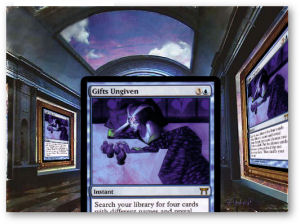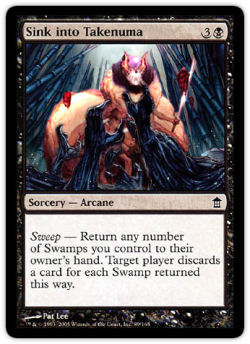Hello, this is Masashi Oiso. This is my first time writing an article here at StarCityGames.com but I hope you will give me a warm welcome. It’s already late in the season now, but in this article I’m going to be discussing Kamigawa Block Constructed. Today I will be discussing the details for the Gifts Ungiven Control deck I used to Top 8 at Grand Prix: Taipei.
It is clear that Gifts Control is the best deck in this format, especially when looking at the results from GP Minneapolis, Niigata, and Taipei. With the synergy of Sensei’s Divining Top and Kodama’s Reach/Sakura-Tribe Elder and the combo of Gifts Ungiven and Hana Kami, the capability of this deck to control the game is incomparable to the other decks in the format.
Once you know that, it becomes an easy choice to play this deck, but the biggest concern for players of this deck is time. With the amount of shuffling, activating Sensei’s Divining Top every turn, and casting Gifts Ungiven, both you and your opponent will end up deliberating for a long period of time during each game. For these reasons, it is important to not waste time during sideboarding, considering what cards to bring in and out. The best way to decrease the amount of time spent on playing the deck is to practice, but for reference, I will be writing about the strategy and sideboarding plans for the Gifts Ungiven deck using my GP: Taipei deck as a guide.
Creatures (14)
- 4 Sakura-Tribe Elder
- 1 Ink-Eyes, Servant of Oni
- 1 Meloku the Clouded Mirror
- 2 Kokusho, the Evening Star
- 1 Myojin of Night's Reach
- 1 Hana Kami
- 1 Ghost-Lit Stalker
- 3 Kagemaro, First to Suffer
Lands (23)
Spells (23)


Mirror Match:
Unless your opponent can out-land you, the mirror matchup in game 1 will be decided on who casts Gifts Ungiven. Your Gifts target should be a legend your opponent has in play, Hana Kami, Soulless Revival, and Death Denied. If you have eight mana available, it’s also good to mix in Myojin of Night’s Reach. Also, when you are behind on mana it may be good to choose Kodama’s Reach and Sakura-Tribe Elder as the Gifts targets. For the most part, you will be naming Gifts Ungiven with Cranial Extraction in the mirror as well.
For games two and three, the lack of mana acceleration will commonly be a problem. Therefore for games two and three, most hands without mana acceleration should be mulliganed.
Sideboard
Out: 2 Hideous Laughter, 2 Kagemaro, First to Suffer, 2 Wear Away, 1Swamp.
In: 2 Godo, Bandit Warlord, 2 Meloku the Clouded Mirror, 1 Umezawa’s Jitte, 1 Tatsumasa, the Dragon’s Fang, 1 Mountain.
It is better to leave one Kagemaro, First to Suffer in because if you take out all the wrath effects, you will lose if your opponent happens to cast Meloku the Clouded Mirror first. If you have a Mountain in your sideboard, you can either increase your land count to twenty-four or swap it with a Swamp. It is questionable whether or not you should leave Cranial Extraction in the deck after sideboarding. I believe you should leave it in, because many of the games after board will still be won off of who casts Gifts Ungiven first or the most. You may also Extraction for Kokusho, the Evening Star or Godo, Bandit Warlord for games two and three to limit the amount of threats your opponent can field against you.
White Weenie:
You shouldn’t lose game one very often if you just watch out for Hokori, Dusk Drinker. You shouldn’t be tapping out during this matchup unless you have a Sickening Shoal and another Black card in hand. Against White Weenie, you generally Gifts for Kagemaro, First to Suffer, Goryo’s Vengeance, Hana Kami, and Soulless Revival. Depending on the situation, you will also mix in Hideous Laughter and Wear Away. When your life points are getting low, make sure to watch out for Shining Shoal.
Sideboard
Out: 1 Kokusho, the Evening Star, 2 Ink-Eyes Servant of Oni, 1 Myojin of Night’s Reach, 1 Ghost-Lit Stalker
In: 1 Hideous Laughter, 1 Exile into Darkness, 1 Rending Vines, 2 Pithing Needle
Hands without mana accelaration or hands that are relying just on Kagemaro won’t be enough against White Weenie for game two and three, since your opponent will most likely bring in cards like Orb of Dreams and Pithing Needle. Because of these reasons, you should mulligan aggressively for this matchup to make sure you will hit your lands and also have removal available.

Mono Black:
This matchup will heavily be decided on whether or not you can use your Top. You should be able to win this matchup unless you don’t have a Top or if your opponent has a Pithing Needle naming Sensei’s Divining Top. Yes, it seems like a surprisingly simple way to explain this matchup, but that’s generally how it works out.
After sideboarding, the number of Kagemaros you are running must be decreased since Sink Into Takenuma can be so devastating. Also all the other Black creatures should be taken out, because Razorjaw Oni will make them ineffective. Although putting in Godo, Bandit Warlord and the equipment increases the chances you will get mana screwed, they should still be brought in. This matchup is actually the most difficult matchup to choose which cards to swap in and out in the format, but I think the best way to sideboard against this deck is like this:
Sideboard
Out: 1 Kokusho, the Evening Star, 2 Kagemaro, First to Suffer, 1 Ink-Eyes, Servant of Oni, 1 Myojin of Night’s Reach, 1 Ghost-Lit Stalker, 1 Cranial Extraction.
In: 1 Godo, Bandit Warlord, 2 Meloku the Clouded Mirror, 1 Umezawa’s Jitte, 1 Tatsumasa, the Dragon’s Fang, 1 Rending Vines, 1 Exile into Darkness
I’m still trying to figure out if Pithing Needle or Isao, Enlightened Bushi should be brought it. You want to generally save your Wear Away and Rending Vines for your opponent’s Pithing Needle, so I would want to add another answer for Umezawa’s Jitte. Isao, Enlightened Bushi will be a great blocker as long as your opponent doesn’t have a Jitte on the board. After sideboarding, I don’t think it will be necessarry to bring in Hideous Laughter, since your opponent will never have multiple two-toughness creatures in play at the same time.
MUC:
It will be important to use your removal wisely throughout the match so that Jushi Apprentice and Azami, Lady of Scrolls don’t stay on board. Ink-Eyes, Servant of Oni will be the most important card in the matchup so Sakura-Tribe Elder should not be sacrificed unless you absolutely have to. I’ve recently seen people starting to play Squelch, so you should be cautious, especially when you are low on lands.
Sideboard
Out: 1 Kokusho, the Evening Star, 2 Myojin of Night’s Reach, 1 Kagemaro, First to Suffer, 1 Hideous Laughter, 1 Cranial Extraction, 1 Wear Away
In: 1 Pithin Needle, 2 Ink-Eyes, Servant of Oni, 1 Isao, Enlightened Bushi, 1 Ghost-Lit Stalker, 1 Rending Vines, 1 Horobi’s Whisper
Ghost-Lit Stalker won’t just be channeled – he gets hardcast pretty often as well. They shouldn’t have any Threads of Disloyalty left in their deck after sideboard so you should be cautious about Squelch rather than Threads – they can’t really activate him if they steal it anyway.
U/G (including Red splash):
Generally unless they out-land you with Sakura-Tribe Scout, you should be able to win. By casting a creature after they cast theirs, you should be able to win off of Gifts Ungiven advantage. Especially since Sickening Shoal will hit all their creatures except for Kodama of the North Tree, you should be able to win if you are on the play. Like the mirror match, most games will be decided on who has the bigger mana advantage, so watch your opening hand after sideboarding. At worst, your Kodama’s Reach will be countered stunting your board development and putting you in a hole.
Sideboard
Out: 1 Kokusho, the Evening Star, 2 Myojin of Night’s Reach, 1 Hideous Laughter, 1 Ghost-Lit Stalker, 1 Cranial Extraction
In: 1 Ink-Eyes, Servant Oni, 1 Meloku the Clouded Mirror, 1 Isao, Enlightened Bushi, 1 Horobi’s Whisper, 1 Rending Vines, 1 Pithing Needle
I believe that you want to keep your mana curve low for this matchup so I don’t side in Godo, Bandit Warlord. Even if my opponent is splashing Red for Godo, Bandit Warlord, I still wouldn’t bring mine in. One minor concern here is that you are taking out so many Black cards that you won’t be able to utilize the alternate cost on Sickening Shoal. I also fear my opponent gaining a large tempo advantage from countering my Kokusho, the Evening Star with Hisoka’s Defiance, but if you want to you can leave in Kokusho, the Evening Star and leave out Pithing Needle or Rending Vines instead.
I’ve given you my general ideas about the Gifts control deck, but there are still many more possibilities for the sideboard slots and ways to sideboard for each matchup. Right now it has become a common strategy to side in Godo, Bandit Warlord, but you can get a solid advantage in the Gifts mirror just by increasing the number of Kokusho, the Evening Star just like Masahiko Morita did in Taipei. With Morita’s sideboard strategy, you can increase your sideboard slots and utilize your sideboard even better, so I believe it should be something that should be tried out, especially if you are comfortable playing the deck. It’s difficult to pick the right cards and choose the correct play for Gifts Control because of how difficult the deck is, but I believe that makes it much more fun and you can fine tune the deck in different ways. I hope this article can be of some help when you are deciding on how to tune your own version of Gifts Control as well.
Well, it’s gotten kind of late so I must get going now. Maybe we will see one another at a tournament soon…
Translated by Takanobu Sato
